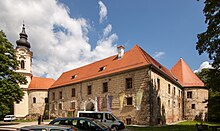Degree (Goričko)
| Degree | |||
|
|||
| Basic data | |||
|---|---|---|---|
| Country |
|
||
| Historic region | Übermurgebiet / Prekmurje | ||
| Statistical region | Pomurska (Mur region) | ||
| Coordinates | 46 ° 48 ' N , 16 ° 6' E | ||
| surface | 37.4 km² | ||
| Residents | 2,302 (2002) | ||
| Population density | 62 inhabitants per km² | ||
| Post Code | 9264 | ||
| License Plate | MS | ||
| Structure and administration | |||
| structure | local community | ||
| Mayor : | Cvetka Ficko | ||
| Website | |||
Grad (German: Ober Limbach ) is a municipality and a village in Goričko , the hilly part of the historic Prekmurje region in Slovenia . Above the town center, on a basalt tuff hill , is Oberlimbach Castle (Slovene Grad, before 1952 also Gornja Lendava, Hungarian Felsölendva).
geography
The municipality occupies the north-western part of the Goričko Hills and Rifts. The area of the entire municipality of Grad extends over an area of approx. 37.4 km² and borders on the neighboring municipalities: in the north on Kuzma , in the northeast on Gornji Petrovci , in the east and south on Puconci and in the west on Rogašovci .
The municipal area includes the lowlands of the four streams stretching in a north-south direction, the Lukaj, Grački, Spunika and Bezjak brooks with heights of around 250 m and the ridges stretching in between with wooded knolls and hills. The most striking of these heights are: Križarka 413 m, Klemberg 376 m, Popošček 369 m and Gomila 335 m. The entire municipality belongs to the three-country park Raab-Goričko-Őrség .
The municipality has about 2400 inhabitants and consists of the following seven localities. The official Hungarian exonyms from 1890 are given in brackets after today's place names .
|
place
The village of Grad (German Oberlimbach, Hungarian Felsőlendva) is one of the largest settlements in the Goričko hill country with 686 inhabitants (2002) and until 1952 had the official place name Gornja Lendava. The place consists of the small center called "Pörga", which extends around the parish church Maria Himmelfahrt (sv. Marije vnebovzete), and several scattered groups of houses in the lowlands and on the heights around the castle stream (Graški potok).
The settlement developed around the medieval castle, from which, for centuries, the extensive territory in Goričko and partly in Ravensko was administered. In 1365, the settlement was first mentioned as "Waraliafolu" and was referred to as a market in 1478 , " opidum Lyndwa", and again in 1499, "oppidum Felsewlyndwa".
In 1890 the village was officially known as Felsőlendva and had 809 inhabitants, 663 of whom claimed to be Slovenes, 121 as Germans, 23 as Hungarians, and 2 indicated another nationality. The place belonged to the Muraszómbat district (today Murska Sobota ) of Eisenburg / Vas county.
The Trianon Peace Treaty added the village to the Kingdom of SHS . For the place now officially named Gornja Lendava, the following data were determined in the census on January 31, 1921: 1024 Slovenes, 20 Hungarians and 20 Germans, of these 1064 residents 976 professed to be Catholic and 82 to Protestant faith.
The 1931 census found 1020 inhabitants, in 1961 there were 937 and the following figures are known for 1971: 920 inhabitants, 197 houses, 221 households and 702 villagers who lived on income from agriculture.
lock
The massive Grad Castle stands above the parish church and the town center on a basalt tuff hill that slopes steeply on three sides. The current palace building developed from a medieval castle and has been extensively renovated since 1995. The administrative offices of the Goričko Nature Park have been located here since 2003, as has an information center for the Raab-Goričko-Őrség Three-Country Park.
Some rooms on the partially renovated ground floor are used for exhibition purposes , seminars and cultural events, in others workshops have been installed in which the traditional rural handicrafts of potters , weavers , wagons and blacksmiths are presented in the Goričko hill country . A schnapps distillery , a vaulted wine cellar and the typical smoky kitchen complete the ethnological collection.
The castle building, which according to legend should have had 365 rooms, is the largest baroque castle in Slovenia and was once surrounded by a large park in the English style. Many of the stately giant trees survived the post-war period. The majestic tulip trees that grow here are possibly the oldest in Slovenia and share the castle park with red oak , gleditschia , pagoda, plane trees and other exotic woody species.
According to a visitor survey using cognitive maps, the castle, along with Sotinski breg and the Ledavsko jezero and Bukovniško jezero lakes, is one of the most popular sights in the Goričko Landscape Park.
Personalities
- Johann Spech (1767–1836), composer and musician, died here on November 24, 1836.
- György Ede Almásy Count of Zsadány and Törökszentmiklós (1867–1933), ethnologist and Asian researcher, was born here on August 11, 1867.
literature
- Ivan Zelko , Historična Topografija Slovenije I. Prekmurje do leta 1500. Murska Sobota, 1982.
- Matija Slavič, Naše Prekmurje. Murska Sobota, 1999.
- Atlas Slovenije, Ljubljana 1985.
Web links
Individual evidence
- ^ Repertorium locorum objectorumque in XII. tabulis Mappae regnorum ... - János Lipszky (báró) - 1808
- ↑ Slovenija na vojaškem zemljevidu 1763-1787: Sekcije I-6, I-7, I Vincenc Rajšp, Slovenska akademija - ed. 7 - 1995
- ↑ Priročni krajevni leksikon Slovenije, Ljubljana 1996, p. 364.
- ^ From German: Citizens.
- ↑ Petra Gostinčar, Boštjan Jerebic, Jani Kozina, Barbara Lampič, Karmen Peternelj & Jernej Tiran: Krajinski Park Goričko: Omejitve in možnosti za razvoj zavarovanega območja. In: Tatjana Kikec (ed.): 20. Zborovanje Slovenskih Geografov - Pomurje Trajnostni regionalni razvoj ob reki Muri , Murska Sobota 2009, pp. 341–353 (Slovenian). Online PDF , accessed June 26, 2018.



